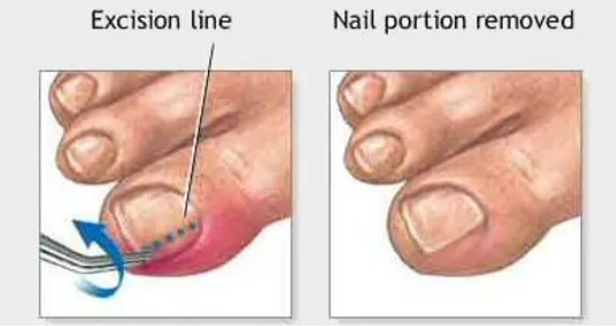Ingrown Toenail Removal Treatment
An ingrown toenail is a painful condition of the toe. It occurs when a sharp corner of the toenail digs into the skin at the end of or side of the toe. Pain and inflammation at the spot where the nail curls into the skin occur first. Later, the inflamed area can begin to grow extra tissue or drain yellowish fluid. If left untreated, an ingrown toenail can progress to an infection or even an abscess that requires surgical treatment. Any toenail can become ingrown, but the condition is usually found in the big toe.
There are many causes for ingrown nails, but the two most common causes are poorly fitting shoes and improperly trimmed nails. Tight shoes compress the side of the nail and alter the fit of the nail in the groove. When nails are peeled off or torn, the edge of the nail can extend down into the corner of the nail groove. A torn nail can irritate the skin next to the nail, producing inflammation (swelling, pain, and redness) and sometimes infection.
When Is Ingrown Toenail Removal Necessary?
Ingrown toenails irritate the skin. As a result, they can make it easier for bacteria and other microbes to get in, which increases the risk of infection. Promptly treating an ingrown toenail reduces this risk. Some signs of infection include:
Ingrown Toenail Removal Procedure
Ingrown toenail surgery usually involves the use of local anesthesia. Local anesthesia means that the person remains awake, but the doctor numbs the area so that the person cannot feel their toe. A chiropodist removes a portion of the toenail to prevent it from digging into the skin. This procedure is also called a Partial Nail Avulsion.
A Total Nail Avulsion (TNA) procedure can also be done as well, which involves the safe removal of the entire toenail.

Recovery
You should keep your foot elevated for a few hours and rest on the day of the surgery; the next day, you can return to work or school. You should refrain from running or vigorous exercise for 2 weeks after the surgery. For most people, the wound will heal within several weeks. The pain will steadily lessen in the days following surgery and should have gone by the time the wound heals.
A person can help speed their recovery after ingrown toenail surgery by:
*You can book online for limited appointment times. Please call or email to book at other times.
SERVICES OFFERED
CLINIC HOURS
| Monday – Friday | 10:00 – 6:00 |
| Weekend | Closed |
| House Visits | Upon Request |
BOOKING & CONTACT
CLINIC HOURS
| Monday – Friday | 10:00 – 6:00 |
| Weekend | Closed |
| House Visits | Upon Request |
